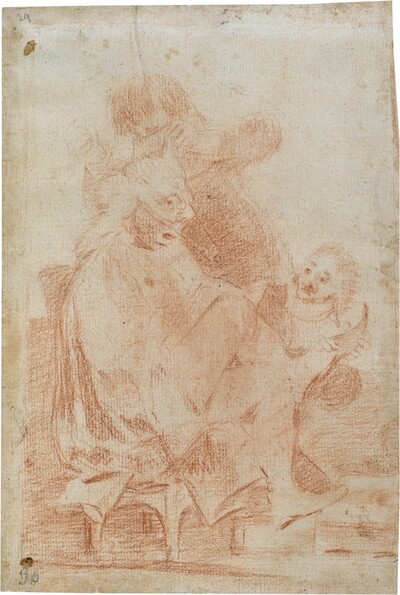- Cronología
- Ca. 1797 - 1799
- Dimensiones
- 219 x 148 mm
- Técnica y soporte
- Etching, burnished aquatint and drypoint
- Reconocimiento de la autoría de Goya
- Undisputed work
- Ficha: realización/revisión
- 08 Dec 2010 / 29 May 2024
- Inventario
- 225
This is what reading is all about. (at the bottom)
98. (in the upper right-hand corner)
See Francisco de Goya y Lucientes, Painter.
A preparatory drawing of this engraving has survived.
A grotesque old man is sitting on a low chair with his legs crossed. One of his feet is placed on a brazier while the knee that is raised supports the book he seems to be reading, although his eyes are closed. Behind him a servant is sprinkling powder on his head while another kneeling man is putting on his shoes.
The scene is very dark, and it is even difficult to make out what the two servants look like, while the figure of the old man pretending to read captures all the light in the engraving. The painter has left a large, lighter surface on his clothes and on his white-haired head. The aquatint used is two grains of different thicknesses. Goya obtains a wide variety of tones, although in later editions the aquatint and pale tones gradually disappear.
Ayala's manuscript notes about this engraving that "the ministers wait until the last minute to find out about business. This one has his hair combed, is shod and sleeps. Who wastes time? This meaning is reiterated in the other two manuscripts, the one in the Prado Museum and the one in the National Library.
In this print Goya openly criticises the frivolity and ignorance of the upper classes and the country's leaders. He describes their approach to culture as superficial, as a mere appearance, and as a low priority in their lives.
This type of reproach is also found in some satirical pamphlets of the time, such as Benito Cano's The Inoculation of the Understanding (1789), which satirises those who own books but do not read them.
The aquatint is somewhat weakened (National Chalcography, no. 200)
-
Goya. Gemälde Zeichnungen. Graphik. TapisserienKunsthalle BaselBasle1953from January 23th to April 12th 1953cat. 219
-
De grafiek van GoyaRijksmuseum RijksprentenkabinetAmsterdam1970from November 13th 1970 to January 17th 1971cat. 28
-
Goya. La década de Los CaprichosMadrid1992organized by Real Academia de Bellas Artes de San Fernando sponsored by Fundación Central Hispano, Madrid, consultant editor Nigel Glendinnig. From October 26th 1992 to January 10th 1993cat. 118
-
Francisco de GoyaMuseo d'Arte ModernaLugano1996exhibition celebrated from September 22nd to November 17th.cat. 29, p.56
-
Francisco Goya. Sein leben im spiegel der graphik. Fuendetodos 1746-1828 Bordeaux. 1746-1996Galerie KornfeldBern1996from November 21st 1996 to January 1997cat. 35
-
Francisco Goya. Capricci, follie e disastri della guerraSan Donato Milanese2000Opere grafiche della Fondazione Antonio Mazzottap.28, cat. 29
-
Goya e la tradizione italianaFondazione Magnani RoccaMamiano di Traversetolo (Parma)2006consultant editors Fred Licht and Simona Tosini Pizzetti. From September 9th to December 3th 2006cat. 29, p.153
-
Goya. Opera graficaPinacoteca del Castello di San GiorgioLegnano2006exhibition celebrated from December 16th 2006 to April 1st 2007p.31
-
Goya e ItaliaMuseo de ZaragozaZaragoza2008organized by the Fundación Goya en Aragóna, consultant editor Joan Sureda Pons. From June 1st to September 15th 2008cat. 324
-
Goya et la modernitéPinacothèque de ParisParís2013from October 11st 2013 to March 16th 2014cat. 153
-
Goya engravings and lithographs, vol. I y II.OxfordBruno Cassirer1964p.99, cat. 64
-
Vie et ouvre de Francisco de GoyaParísOffice du livre1970p.179, cat. 508
-
Goya, la década de los caprichos: dibujos y aguafuertesMadridReal Academia de Bellas Artes de San Fernando1992pp.200-201, cat. 118
-
Catálogo de las estampas de Goya en la Biblioteca NacionalMadridMinisterio de Educación y Cultura, Biblioteca Nacional1996p.89, cat. 118
-
El libro de los caprichos: dos siglos de interpretaciones (1799-1999). Catálogo de los dibujos, pruebas de estado, láminas de cobre y estampas de la primera ediciónMadridMuseo Nacional del Prado1999pp.180-183
-
ParísPinacoteca de París2013p. 218
-
Goya. In the Norton Simon MuseumPasadenaNorton Simon Museum2016pp. 42-75

